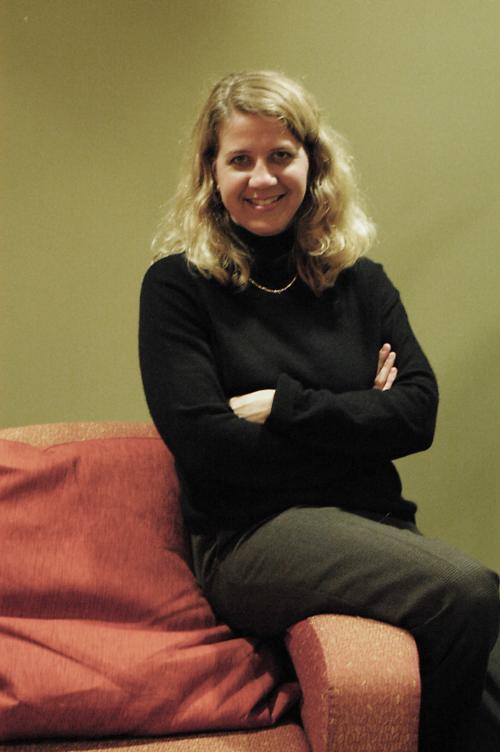
A Room of Their Own
Plush, comfortable couches and fluffy floor cushions. A tastefully mellow color scheme. On the television, that feminist-lite icon of the 1990s, “Sabrina the Teenage Witch.”
Welcome to the Harvard College Women’s Center, whose current offerings—free photocopying for student organizations and free coffee—complement the mild and pleasant decor. Indeed, students of all persuasions enjoy the comfortable atmosphere.
Rafael A.P. Miranda ’09 goes to the Center every Friday to work on organic chemistry problem sets, unfazed by its gendered name.
“I feel so comfortable coming in here,” he says. “It’s not a problem at all.”
Krista E. Weiss ’09, also working on orgo, chimes in with her appreciation for the atmosphere: “You don’t want to go to Lamont, where everyone is studying. Here you can talk, you can hang out.”
Currently, the Women’s Center largely serves as a hangout for all students. But as the Center begins to stage more programming targeted specifically at women, its challenge is to focus on gender issues without losing the broad appeal it currently enjoys.
RADCLIFFE NO MORE
In 1999, Radcliffe was formally absorbed into Harvard College. With its replacement by the Radcliffe Institute for Advanced Studies, female undergraduates no longer received diplomas signed by both presidents.
Shauna L. Shames ’01, now at the Graduate School of Arts and Sciences and an intern at the Women’s Center, was an undergraduate at the time of the merger. She remembers the push for a Women’s Center that followed Radcliffe’s break from the undergraduate community.
“Harvard had never had to deal with the needs of specifically the female undergraduates, because Radcliffe was always there,” says Shames, an early member of the committee to establish a woman-friendly space on a male-dominated campus.
The value of such a space remains controversial today, nearly two months after the Center’s Sept. 21 opening.
Meghan E. Grizzle ’07 recently published a scathing review of the Women’s Center in the Harvard Salient, a conservative biweekly .
In her review, Grizzle described the “overwhelming presence of...pro-feminist materials in the Center” as “more than a little disconcerting.” She noted that the bookshelves were full of feminist tomes, lacking entirely the conservative voice.
Grizzle says that she appreciates the central location and—of course—the limited free printing.
“I just feel like they could have a little bit more diversity,” she says.
‘ALL GENDERS WELCOME’
The Center takes pains not to exclude men. A sign outside Canaday B reads, “All Genders Welcome!”
“A good number of guys come down, asking if they’re welcome,” says Shirley Lemus Hufstedler ’07, another intern. “Guys are surprised to see that we have absolutely no problem with guys down here at any time.”
Grizzle says she was surprised at the choice of names. If the Center is so welcoming to men, why bother designating it as specifically a “Women’s Center”?
“I think a lot of what they want it to focus on is beneficial to all students,” Grizzle says. She wishes the Center had chosen a more general title.
Shames defends the Women’s Center against such criticisms. “This place is unique in its focus on women and gender,” she says. “It doesn’t and shouldn’t take the place of a student center.”
Director of the Harvard College Women’s Center Susan B. Marine emphasizes that the Women’s Center centralizes the already-existing resources related to women’s issues.
“We run a large mentor program, we provide funding for women’s issues events through the [Ann Radcliffe Trust],” says Marine. “Our mission is very different from a student center, yet we’re also to trying to be a comfortable space and I don’t think those goals are in conflict.”
FOCUS ON FEMALES
Marine stresses that the Center is open to feedback. After hearing concerns about its prominent location, the basket of free condoms was moved someplace more discreet.
“The second time I came they had moved it to a less prominent place,” concedes Grizzle.
Because of the difficulties associated with opening a new Center, Marine says, there won’t be a formalized program schedule until spring 2007. In the meantime, the Center is kicking off weekly movie, knitting, and meditation nights, “things that people have indicated they’re interested in,” says Marine.
Come January, the Center will begin to offer more serious fare, including monthly dinners with notable alumnae, the Women’s Leadership Awards in April, and an educational series on financial literacy and women’s health topics.
Those “ideologically opposed to the Center,” as Grizzle phrases it in her article, may never be satisfied with any justification for the Women’s Center. But even those who see it as just another student center may look at the new programming and see it in a different light.
After all, as Marine puts it, “I don’t think what we’re here to do is serve coffee and make copies.”


